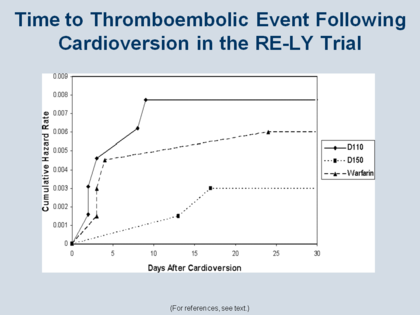Steven A. Rothman, MD - AFib Treatment: General Population - Figure 29
Time to Thromboembolic Event
What about alternatives to warfarin in conjunction with elective cardioversion? As discussed in the previous presentation, 3 novel anticoagulants (NOACs) have become available in the last year that address many of the challenges and difficulties of warfarin. The only clinical trial data available at this point regarding use of a NOAC in conjunction with cardioversion come from a subset of patients from the RE-LY trial, using dabigatran.[78] As shown in the Figure, the dose of dabigatran is all-important, for the higher 150 mg dose (D150) resulted in a much lower cumulative risk of thromboembolic events compared with warfarin, but the lower, 110 mg dose (D110) resulted in a rather higher cumulative risk. Nevertheless, in 1800 cardioversions performed in this study, the overall cumulative risk of stroke was very low with any of these anticoagulation regimens.
Rothman SA. Am J Med 2013; 126: 00-00.
[RE-LY = Randomized Evaluation of Long-Term Anticoagulation Therapy]

